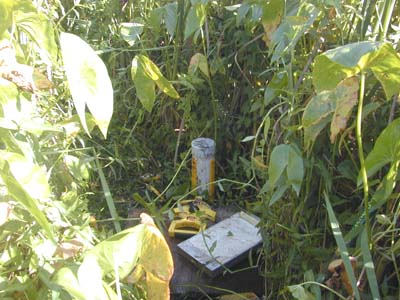

The PVC mat penetration device, Well A5 at Sta. A5, is located west of the hyacinth-covered central pond. The vegetation in this area is dominated by arrowhead plant, cattail, and some para grass. The mat here is clearly floating, and stopping to take measurements results in the local surface becoming depressed and flooded.
- The following legend applies to the graph above:
- Blue line is height of water above the "solid" bottom. Green line represents "top of mat" calculated from tape reading from solid bottom to pipe lip minus pipe extension value. A "mat depression factor" is added to correct for temporary sinking of the mat that occurs during the taking of measurements. The brown line represents the lower edge of extensive roots penetrating the vegetation mat, below which occurs a soft muck through which the weighted line readily sinks. A water layer has yet to be detected here.
|
Sta. GPS: Date installed: Pipe length: Ext. above mat: Mat thickness: Under mat: |
Sep. 6, 2002 2.45 ft. 0.92 ft. 0.95 ft. muck |
Water level (blue line on graph; measured as the distance from the "solid" bottom to the water surface in the well and not significantly influenced by the weight of the investigator) seems more variable than might be expected, given the location near the middle of Kawai Nui. Proximity to the central marsh flow arising from stream inputs may hold the answer -- that is, the marsh is behaving more like a sponge than a large lake); or, as yet unknown properties of the muck layer, may be responsible. The rainfall on October 15 produced a rise in the marsh surface and the water level similar to that measured at Well A2 for the same rainfall event; and shows a similar stability in water and mat elevations since the end of the dry season. These changes are somewhat hybrid between the wet meadow model and the floating mat model of the marsh.